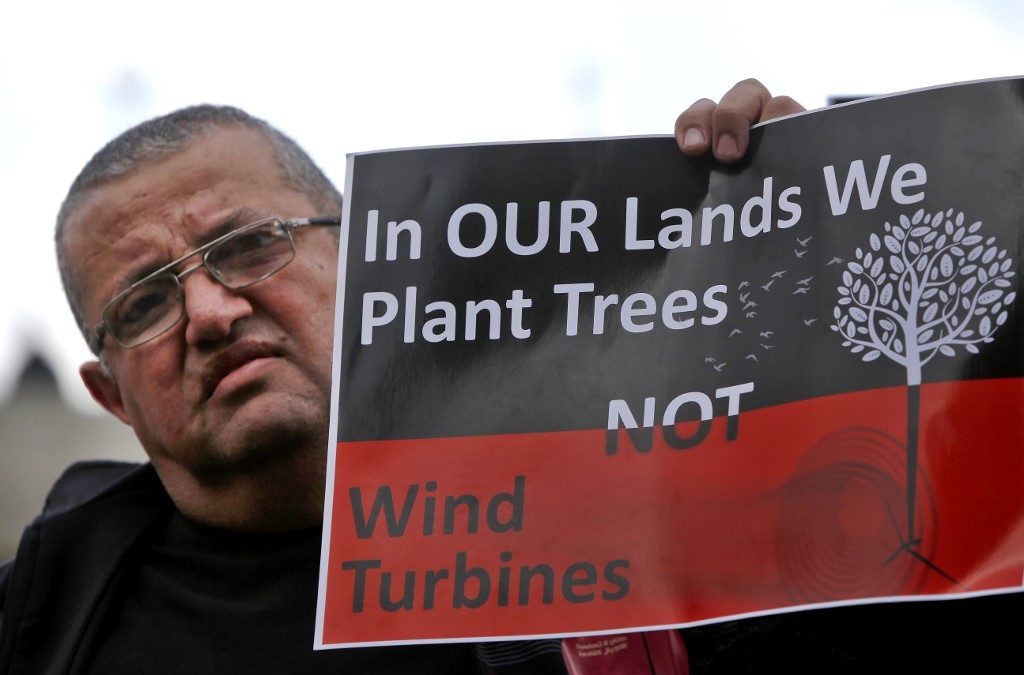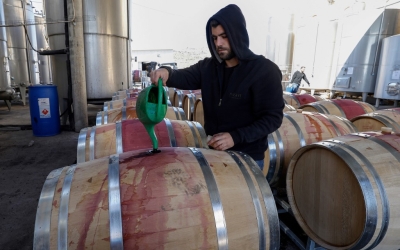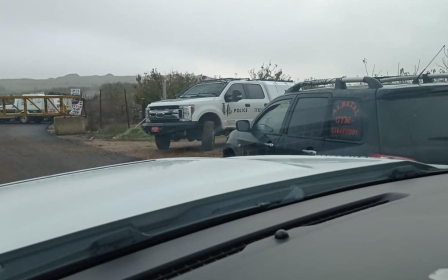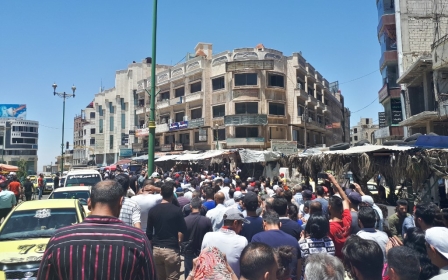Syrians in Golan Heights wounded and arrested in clashes with Israeli forces

Ten Syrians in the occupied Golan Heights were wounded by Israeli military police on Wednesday as they protested against the construction of wind turbines to generate electricity which will benefit Israel's settlements in the area.
Syrian Druze have called for a general strike and for shops and schools to close, and gathered to protest.
Israeli forces cracked down on a protest in an orchard, where ten Syrians were wounded when shot at by tear gas and rubber-coated bullets.
Israeli military police said that around 300 Syrian Druze protested against the construction and installation of the wind turbines on their land.
Eight were arrested, and ten were evacuated for medical treatment, while four Israeli policemen were injured, Kan news reported.
New MEE newsletter: Jerusalem Dispatch
Sign up to get the latest insights and analysis on Israel-Palestine, alongside Turkey Unpacked and other MEE newsletters
The Golan Heights: Why it matters
+ Show - HideOfficially part of Syria since the country’s independence in 1944, the Golan Heights is a strategic plateau straddling Israel and Syria and overlooking southern Lebanon.
It was captured by Israel during the Middle East war of 1967 and subsequently annexed in a move never recognised by the international community.
The Golan is recognised as part of Syria by the United Nations. UN Resolution 242 calls for Israel to withdraw from the Golan and other occupied territories including the Gaza Strip and the West Bank.
However, Israel has repeatedly refused to do so and in 1981, it formally annexed the Syrian territory.
A UN peacekeeping force has patrolled the demarcation line between Syrian and Israeli-controlled areas of the Golan since 1974.
Israel has constructed settlements that are illegal under international law in the occupied territory and settled its citizens there.
Some 20,000 Israeli settlers currently live in the Golan, alongside around 26,000 of the territory’s native inhabitants, who are predominantly Druze and identify as Syrian.
Since the Syrian war erupted in 2011, Syrians in the Golan taking Israeli citizenship has become more common, though the vast majority reject it.
The Golan is thought to provide around one-third of Israel's fresh water supply. Water from the territory flows into the Sea of Galilee and Jordan River.
Other than its strategic significance - the Golan is the only land border between Israel and Syria - the territory is also used by Israelis for leisure purposes. The area counts an Israeli ski resort and several vineyards.
Earlier this week, Israeli forces closed the Syrian Druze areas to test the soil and ship digging equipment for the installation of the wind farm. They have barred Syrian Druze access to their land and blocked the roads.
Four Syrian villages were occupied in 1967 during the Middle East war and later annexed by Israel in 1981 in a move that was not recognised internationally.
Almost 22,000 Syrian Druze live in the villages of Majdal Shams, Buqata, Masada, Ein Qiniyye, and a similar number of Israelis live in around 30 settlements and agriculture outposts in the area.
Israel has tried to impose Israeli citizenship on the Syrian Druze but they refused to accept it in 1982.
The wind farm project is part of the 2009 Israeli strategy to increase the county’s dependency on renewable energy to 10 percent by 2020.
There are several Israeli and international companies involved in developing wind turbines in Golan Heights, including Energix Renewable Energies, Enlight Renewable Energy and General Electric.
Wednesday's protest was directed at Energex Group's development and the company's employees were escorted by Israeli military police.
In May, Energix has denied allegations of "environmental harm" or threatening the livelihood of the Syrian Druze, saying the wind farm project will create jobs for the local community.
In 2015, Israeli company Enlight Renewable Energy won significant licences to build an energy project in three areas in the occupied Golan Heights, which will produce 400 megawatts of electricity annually using wind-driven turbines.
The project includes three wind farms in the north and the centre of the Golan Heights dubbed the Vale of Tears, Valley of Winds and Valley of God. But only the first project, Vale of Tears, has been advanced since 2015.
Residents from four Syrian Druze villages of Majdal Shams, Buqata, Masada, Ein Qiniyye said the Israeli wind farms projects in the Golan Heights will affect about 3,600 dunams (890 acres) of their apple, grapes and cherry orchards.
The wind farms will limit the expansion of the villages, which are beside a mountainous slope. Masada and Majdal Shams are also surrounded by closed military zones and minefields, and the residents have limited space to expand for building houses.
The Golan Heights and the Jordan Valley are two areas used by the Israeli military for battlefield scenarios and exercising manoeuvres.
In March 2019, the administration of US President Donald Trump unilaterally recognised Israel’s hold on the occupied Syrian Golan Heights, a move that drew international criticism. Israeli settlers responded by naming a settlement after him, called Trump Heights.
Middle East Eye delivers independent and unrivalled coverage and analysis of the Middle East, North Africa and beyond. To learn more about republishing this content and the associated fees, please fill out this form. More about MEE can be found here.





